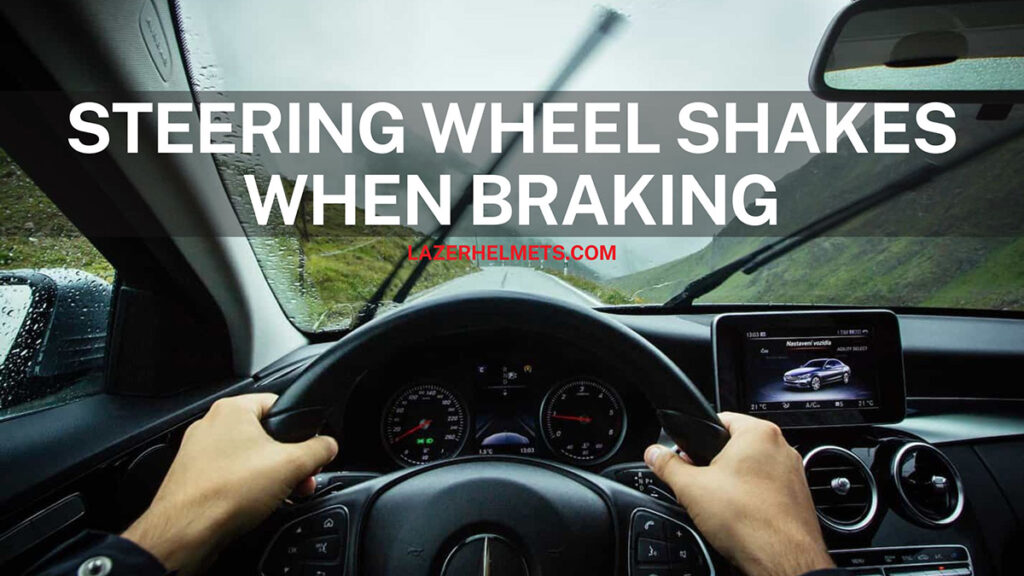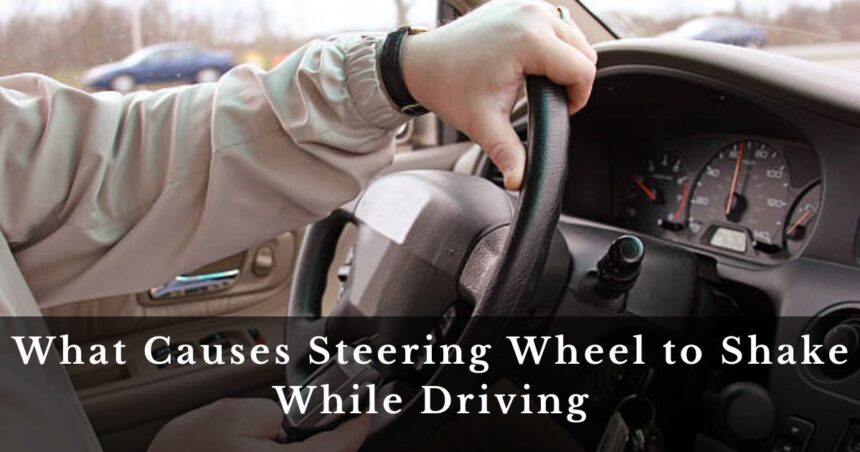What is the cause of steering wheel shaking? This unsettling vibration can range from a minor annoyance to a serious safety concern, impacting your driving experience and potentially compromising vehicle control. The culprit behind this issue could lie within various components of your vehicle, each playing a critical role in maintaining a smooth and stable ride. Understanding the possible causes of steering wheel shaking is crucial for ensuring a safe and enjoyable driving experience.
From misaligned wheels and worn tires to faulty suspension components and compromised braking systems, numerous factors can contribute to this issue. By carefully inspecting key components and understanding the mechanics behind their operation, you can effectively diagnose the root cause and address it accordingly.
Wheel Alignment Issues

A misaligned steering wheel can cause shaking, especially at higher speeds. When your wheels are not properly aligned, they don’t track straight, leading to uneven tire wear and a compromised driving experience.
Causes of Wheel Alignment Issues
The alignment of your vehicle’s wheels is crucial for a smooth and safe ride. If your wheels are misaligned, it can cause a number of problems, including steering wheel shaking. Here are some common causes of wheel alignment issues:
- Hitting a pothole or curb: This can knock your wheels out of alignment, causing the steering wheel to shake.
- Uneven tire wear: If your tires are worn unevenly, it can also affect the alignment of your wheels.
- Loose steering components: Worn or loose steering components, such as tie rods, ball joints, or control arms, can affect the alignment of your wheels.
- Improper suspension parts: Damaged or worn suspension components, such as shock absorbers or springs, can also lead to wheel alignment issues.
How Misaligned Wheels Cause Steering Wheel Shaking
Misaligned wheels cause the steering wheel to shake because the tires are not rolling in a straight line. This can lead to a number of problems, including:
- Uneven tire wear: When your wheels are misaligned, the tires will wear unevenly. This can cause the steering wheel to shake, as well as reduce the lifespan of your tires.
- Reduced fuel efficiency: Misaligned wheels can also lead to reduced fuel efficiency, as the tires have to work harder to roll.
- Steering wheel vibration: When the tires are not rolling in a straight line, they can vibrate, which can be felt in the steering wheel.
- Difficult steering: Misaligned wheels can also make it difficult to steer your car, especially at higher speeds.
Wheel Alignment Process
A wheel alignment is a relatively simple process that involves adjusting the angles of your wheels to ensure they are properly aligned. The process typically involves:
- Inspection: A technician will inspect your vehicle’s suspension and steering components to identify any problems.
- Adjustment: The technician will then adjust the angles of your wheels using specialized equipment. This may involve adjusting the tie rods, control arms, or other suspension components.
- Testing: After the adjustment is made, the technician will test the alignment of your wheels to ensure they are properly aligned.
Wheel alignment is essential for maintaining the safety and performance of your vehicle. If you notice any signs of misalignment, such as steering wheel shaking or uneven tire wear, it is important to have your wheels aligned as soon as possible.
Tire Problems

Tire problems can be a significant cause of steering wheel shaking. Worn, unevenly worn, or damaged tires can disrupt the smooth rolling motion of your vehicle, leading to vibrations that travel up through the steering wheel.
Worn Tires
Worn tires, especially those with uneven wear patterns, can contribute to steering wheel shaking. As tires wear down, the tread depth decreases, reducing the tire’s ability to grip the road surface. This can lead to vibrations, particularly at higher speeds.
Uneven Tire Wear
Uneven tire wear, such as feathering or cupping, can also cause steering wheel shaking. Feathering occurs when the tire wears down at an angle, creating a pattern that resembles feathers. Cupping, on the other hand, involves the formation of depressions or dips in the tire tread. Both feathering and cupping can result from misaligned wheels, worn suspension components, or improper tire inflation.
Damaged Tires
Damaged tires, such as those with punctures, bulges, or sidewall cracks, can also cause steering wheel shaking. These damages can compromise the structural integrity of the tire, leading to uneven wear and vibrations.
Inspecting Tires
Regularly inspecting your tires is crucial for identifying potential problems that could cause steering wheel shaking. Here are some tips for inspecting your tires:
- Check the tread depth: Use a tread depth gauge or a penny to check the remaining tread depth. The minimum legal tread depth in most countries is 2/32 of an inch.
- Look for uneven wear patterns: Examine the tire tread for signs of feathering, cupping, or other uneven wear patterns.
- Inspect for damage: Check the tire for punctures, bulges, sidewall cracks, or any other damage.
Suspension System Malfunctions: What Is The Cause Of Steering Wheel Shaking
The suspension system plays a crucial role in maintaining vehicle stability and ensuring a smooth ride. It acts as a buffer between the vehicle and the road, absorbing bumps and irregularities. A properly functioning suspension system helps to maintain tire contact with the road, contributing to safe handling and control. However, when suspension components wear out or malfunction, it can lead to a variety of issues, including steering wheel shaking.
Worn Shock Absorbers
Worn shock absorbers are a common cause of steering wheel shaking, especially at higher speeds. Shock absorbers are responsible for damping the oscillations of the suspension system, preventing excessive bouncing and vibrations. When shock absorbers become worn, they lose their ability to effectively control these oscillations, leading to vibrations that can be felt in the steering wheel.
Worn shock absorbers can cause the vehicle to bounce excessively, leading to a loss of control and an uncomfortable ride.
Loose Control Arm Bushings
Control arm bushings are rubber components that connect the control arms to the vehicle’s frame. They are designed to allow for a small amount of movement while also providing a stable connection. Over time, these bushings can wear out or become loose, leading to excessive movement in the control arms. This can result in vibrations and shaking that are transmitted to the steering wheel.
Loose control arm bushings can cause a clunking sound when going over bumps and can also lead to uneven tire wear.
Other Suspension Components
Other suspension components that can contribute to steering wheel shaking include:
- Worn ball joints: Ball joints connect the control arms to the steering knuckles and allow for the wheels to turn. Worn ball joints can cause a clunking sound when turning and can also lead to vibrations in the steering wheel.
- Worn tie rod ends: Tie rod ends connect the steering rack to the steering knuckles and allow for the wheels to turn. Worn tie rod ends can cause a loose steering feel and can also lead to vibrations in the steering wheel.
- Loose suspension components: Any loose suspension components, such as sway bar links or strut mounts, can contribute to vibrations and shaking in the steering wheel.
Braking System Issues
A shaking steering wheel can be caused by problems with the braking system, specifically warped brake rotors or uneven brake pad wear. When brake rotors become warped, they can cause a vibration that is felt in the steering wheel. Uneven brake pad wear can also cause the brakes to grab unevenly, resulting in a shaking sensation.
Inspecting Brake Rotors and Pads
To determine if warped brake rotors or uneven brake pad wear are causing your steering wheel to shake, you can visually inspect the brake system components. This involves removing the wheels and carefully examining the brake rotors and pads.
- Inspecting Brake Rotors: Look for any visible warping, scoring, or grooves on the surface of the brake rotors. Warped rotors will have a noticeable unevenness or a wave-like pattern. If you can feel a ridge or groove with your fingernail, the rotor is likely warped.
- Inspecting Brake Pads: Examine the brake pads for uneven wear. If one pad is significantly thinner than the other, it indicates uneven wear. Also, check for any cracks, splits, or excessive glazing on the pad surface.
It’s important to note that a visual inspection may not always be sufficient to diagnose warped rotors. A more accurate assessment can be done by using a brake rotor micrometer to measure the thickness of the rotor at various points.
Maintaining a Properly Functioning Braking System
Maintaining a properly functioning braking system is crucial for preventing steering wheel shaking and ensuring safe driving. This includes:
- Regular Brake Inspections: Have your brakes inspected by a qualified mechanic at least once a year, or more frequently if you notice any signs of brake problems.
- Brake Fluid Flush: Brake fluid absorbs moisture over time, which can affect its performance. Have your brake fluid flushed every two years or as recommended by the vehicle manufacturer.
- Brake Pad Replacement: Replace brake pads when they wear down to the minimum thickness specified by the manufacturer. This will help prevent uneven wear and premature rotor damage.
- Rotor Resurfacing: If brake rotors are warped, they can often be resurfaced by a qualified mechanic. Resurfacing involves machining the rotor surface to remove any unevenness or grooves. However, if the rotors are excessively worn or damaged, they may need to be replaced.
Steering System Components
A steering system is a crucial part of any vehicle, responsible for directing the wheels and controlling the vehicle’s direction. When components within this system wear out or malfunction, it can lead to a variety of issues, including steering wheel shaking.
Steering Rack Components
The steering rack is a vital component of the steering system that converts the rotational motion of the steering wheel into linear motion, which moves the wheels. Wear or damage to the steering rack’s components can cause steering wheel shaking.The steering rack consists of several important components, including:
- Rack and Pinion: This is the primary mechanism within the steering rack. The rack is a toothed bar that slides back and forth, and the pinion is a gear that meshes with the rack. The pinion is connected to the steering wheel, and as the steering wheel turns, the pinion rotates, causing the rack to slide. This movement is then transmitted to the tie rods, which connect to the steering knuckles and ultimately move the wheels.
- Tie Rods: These are the connecting rods that transmit the motion from the steering rack to the steering knuckles. They are typically adjustable to ensure proper alignment of the wheels.
- Tie Rod Ends: These are the joints that connect the tie rods to the steering knuckles. They are ball joints that allow for some movement and flexibility.
- Steering Knuckle: This is the part of the suspension that connects the wheel to the vehicle. The tie rod ends attach to the steering knuckle, and as the tie rod moves, the steering knuckle turns the wheel.
When these components wear out or become damaged, they can cause the steering rack to operate improperly. This can result in a loose or sloppy steering feel, as well as steering wheel shaking, especially at higher speeds.
Inspecting Steering Rack Components
- Visual Inspection: Look for signs of damage or wear on the steering rack, tie rods, and tie rod ends. Check for cracks, bends, or excessive wear on the rack and pinion. Inspect the tie rods and tie rod ends for any signs of play or looseness. You can check for play by grabbing the tie rod end and moving it back and forth.
If you feel excessive movement, it’s likely that the tie rod end is worn out.
- Steering Wheel Play: Turn the steering wheel back and forth and feel for any play or looseness. If you feel excessive play, it could indicate a problem with the steering rack or its components.
- Noise: Listen for any unusual noises coming from the steering system, such as clunking, grinding, or knocking. These noises can indicate wear or damage to the steering rack or its components.
If you notice any of these signs of wear or damage, it’s important to have your steering rack inspected and repaired by a qualified mechanic.
Other Potential Causes

While the most common causes of steering wheel shaking are related to alignment, tires, suspension, braking, and steering components, there are other less frequent culprits that could contribute to this issue. These often require a more thorough inspection to identify and address.
Loose Wheel Lug Nuts
Loose wheel lug nuts can cause a shaking sensation, particularly at higher speeds. This is because the wheel can wobble slightly when it’s not securely fastened to the hub.
- Inspecting Lug Nuts: To check for loose lug nuts, use a torque wrench to tighten them to the manufacturer’s specifications. The torque specifications can be found in your vehicle’s owner’s manual or online. If you don’t have a torque wrench, use a lug wrench to tighten the nuts as tightly as you can. It’s important to note that tightening them too much can damage the lug nuts or the wheel studs.
- Importance of Regular Inspection: Regularly inspect your lug nuts, especially after rotating your tires or having your wheels serviced. This will help prevent them from loosening and causing steering wheel shaking.
Bent Steering Wheel, What is the cause of steering wheel shaking
A bent steering wheel can also lead to shaking. This is usually a result of a significant impact, such as a collision.
- Inspecting the Steering Wheel: Visually inspect the steering wheel for any bends or deformities. If you notice any irregularities, it’s best to have it checked by a professional.
- Impact of Bent Steering Wheel: A bent steering wheel can affect the alignment of your steering system and cause the steering wheel to shake. It can also make it difficult to steer the vehicle safely.
Seeking Professional Assistance
If you suspect that loose wheel lug nuts or a bent steering wheel are causing your steering wheel to shake, it’s important to have your vehicle inspected by a qualified mechanic. They will be able to properly diagnose the problem and recommend the appropriate solution.
Steering wheel shaking can be a complex issue, but understanding the underlying causes can empower you to diagnose and address it effectively. Remember, regular maintenance, careful inspections, and seeking professional assistance when necessary are crucial steps in ensuring a safe and enjoyable driving experience. By addressing steering wheel shaking promptly, you can maintain vehicle stability, enhance your driving comfort, and prevent potential safety hazards.
General Inquiries
How often should I check my tire pressure?
It’s recommended to check your tire pressure at least once a month, or before a long trip. You should also check your tire pressure after driving on a particularly hot or cold day, as temperature can affect tire pressure.
What are the signs of worn shock absorbers?
Worn shock absorbers can lead to a bouncy ride, excessive body roll in corners, and a longer stopping distance. You may also notice a clunking or banging noise when driving over bumps.
Is it safe to drive with a shaking steering wheel?
While it’s possible to drive with a slightly shaking steering wheel, it’s not recommended. The shaking could be a sign of a serious problem that could worsen over time and potentially lead to a loss of control.
How much does it cost to get a wheel alignment?
The cost of a wheel alignment varies depending on the location and the type of vehicle. However, it’s typically a relatively inexpensive repair compared to other potential problems that could cause steering wheel shaking.